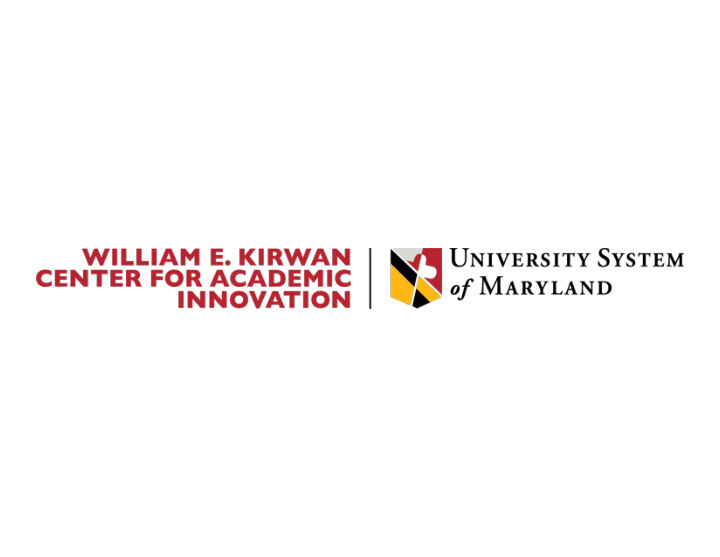



Working with Faculty to Ensure Digital Accessibility Ana Palla-Kane Senior IT Accessibility and UX Specialist, UMCP Sue Johnston Instructional Designer for Accessible Learning, UMCP Tawny L. McManus Assistant Vice Provost for Accessibility & Disability Services, UMBC
IT Accessibility at UMCP Commitment to equal access to information and services to all UMD Web Accessibility Policy 1. All web-based information needs to be created and maintained using the Web Content Accessibility Guidelines - WCAG a. Web pages b. Web content (hypertext, videos, documents, images, audio files, etc.) c. Web-based applications d. Online instructional content, services, and resources 2. Add Web Accessibility Link to the footer
How does the policy apply to online learning & teleworking? Web-based information used for instruction, teleworking and delivery of services 1. Websites - academic and administrative (all services delivered online) 2. eTools and Apps LMS a. b. Conference Platforms 3. Documents Readings and Textbooks a. b. Word, PPT, PDF, other documents 4. Media Video, audio, podcasts, other a.
IT Accessibility becomes priority when delivering all services online Increase collaboration and communication Keep Teaching and Keep Learning accessibility resources • • accessibility@umd.edu & campus wide email message Leverage current resources Include accessibility as part of compliance requirements for all technology Engage community with disabilities (President’s Commission on Disability Issues) Educate community about accessibility and principles of Universal Design for Learning Implementing accessibility is essential for people with disabilities and useful to all
UMCP IT Accessibility Services & Resources Panopto Professional Captioning Canvas Accessibility Auditing Consultation & Training Canvas Design Tools Course Accessibility Checklist Canvas Quiz Extensions Web Accessibility Auditing - Siteimprove DIY Six Essential Steps (plain text version: SensusAccess Document Conversion https://itaccessibility.umd.edu/sites/default/fil (coming soon) es/DIY-Accessibility-Handout-2019-Text.docx) UMCP IT Accessibility webpage www.itaccessibility.umd.edu
IT Accessibility: Six Essential Steps 1. Headings 2. Links 3. Color & Contrast 4. Images 5. Tables 6. Media
From Face-to-Face to Remote Instruction: Lessons learned from the COVID-19 transition How can WE (instructional designers, faculty development staff, IT, disability services…) assist faculty in ensuring their online courses are accessible? Faculty FAQ: What do I “have” to do to make my brick and mortar course virtual versus what “should” I do? Where do I start, who can help me, what are the resources??? Where can I find info/steps? Is this time consuming? Do I have to make sure it’s accessible if I don’t have a student with a disability accommodation letter?
Information & Collaboration #1: Accessibility is for everyone and benefits all. Has your campus had trainings and presentations about accessibility? If you are offering how-to information on how to make your courses accessible, are you making sure participants understand the why? ➔ Collaborating with disability services is essential. ➔ Instructional tech can tell faculty the how of UDL, but making it real with examples of the impact on students when a course is not accessible is important. ➔ Ex. What does the course sound like for a blind student?
How Do We Help Faculty... Websites, checklists, trainings, and messaging Institutions need clear messaging to faculty about remote instruction. UMBC example: • Academic Affairs formed a subcommittee to work on a message to come out from the Provost’s office to all faculty. A direct response to concerns reported and to encourage digital accessibility. Goal: to provide info and resources. Faculty: “Why am I being told to record my lectures in Blackboard Collaborate? My class should be live, synchronous learning just like the classroom. And, I don’t want students to post me teaching on social media. ”
WHY?? To make the course accessible to all students enrolled during the COVID-19 pandemic. 1 -In the event of technical problems (hardware, software, internet connection problems, time zone differences/IES students); 2 -For note taking support, students can stop, start, and create accurate notes from lectures; 3 -For deaf and hard of hearing students, verbatim transcripts can be made if no captions or interpreter support available (allows them to access the instruction); 4 -Students with chronic illnesses and challenging life circumstances (childcare, computer sharing, etc.) can still “attend” your class even if they cannot attend “live” through watching the recording later. 5- There are policies regarding sharing recordings of instructional materials. They are intended for educational use only and cannot be shared for social media. Student conduct sanctions may apply.
Take away quick list questions to ask 1. Synchronous vs asynchronous course delivery (recordings?) 2. Course materials: E-textbooks (ex. VitalSource), Pdfs, videos, publisher-based supplements (MyLab assignments) Are they accessible, captioned, alt formats? 1. Accessibility checkers- MS Office, Adobe, Blackboard Ally… 2. Course set up: discussions, group activities (can everyone participate?) 3. Interpreters, scribes, readers- DSS offices may recommend you add them to the LMS course shell 4. Assessment/testing- timing (set extended time, change format, flexibility if student cannot take it at the same time). What is the learning objective- can they do it quickly versus what do you want to see that they have learned? 5. Platform tools and access: Webex, GoogleMeet, Zoom, Voicethread (virtual office hours, discussions, etc.).
Two additional resources USM IT accessibility webpage - https://www.usmd.edu/it- • accessibility/guidelines/course-materials University of Washington online course accessibility • checklist - https://depts.washington.edu/uwdrs/faculty/online- course-accessibility-checklist/
On a scale of 1 to 5 (1=“yikes!” and 5=“we’re good!”), what is your institution’s readiness to address digital accessibility with respect to: ... current remote teaching efforts? ... a move to online teaching in the fall, if needed? What are some areas of need in terms of capacity-building?
Additional Support Next topical webinar: Wednesday, April 22, 1:00-2:00 pm Facilitating Faculty Use of Diagnostic Assessment for Fall 2020 How else can we help?
Recommend
More recommend